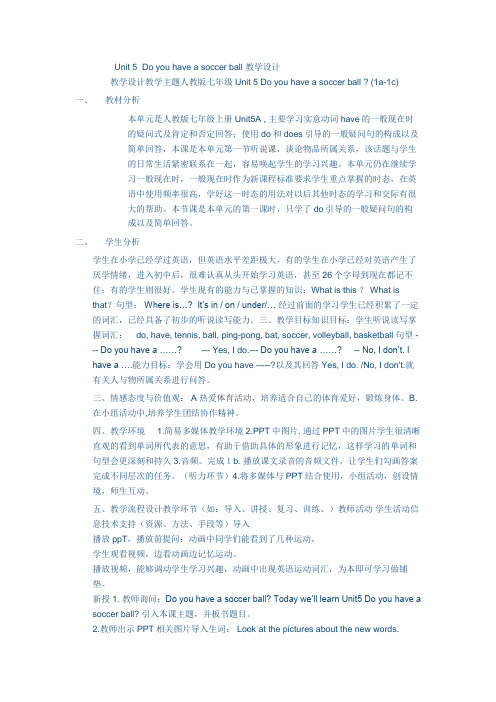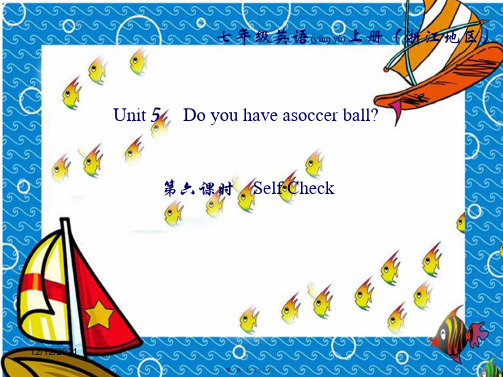海南省万宁市思源实验学校七年级英语上册Unit 5 Do you have a soccer ball 教案
英语人教版七年级上册Unit 5 Do you have a.....

Unit 5 Do you have a soccer ball 教学设计教学设计教学主题人教版七年级 Unit 5 Do you have a soccer ball ? (1a-1c)一、教材分析本单元是人教版七年级上册Unit5A , 主要学习实意动词have的一般现在时的疑问式及肯定和否定回答;使用do和does引导的一般疑问句的构成以及简单回答,本课是本单元第一节听说课,谈论物品所属关系,该话题与学生的日常生活紧密联系在一起,容易唤起学生的学习兴趣。
本单元仍在继续学习一般现在时,一般现在时作为新课程标准要求学生重点掌握的时态,在英语中使用频率很高,学好这一时态的用法对以后其他时态的学习和交际有很大的帮助。
本节课是本单元的第一课时,只学了do引导的一般疑问句的构成以及简单回答。
二、学生分析学生在小学已经学过英语,但英语水平差距极大,有的学生在小学已经对英语产生了厌学情绪,进入初中后,很难认真从头开始学习英语,甚至26个字母到现在都记不住;有的学生则很好。
学生现有的能力与已掌握的知识:What is this ? What isthat?句型:Where is…?It’s in / on / under/… 经过前面的学习学生已经积累了一定的词汇,已经具备了初步的听说读写能力。
三、教学目标知识目标:学生听说读写掌握词汇:do, have, tennis, ball, ping-pong, bat, soccer, volleyball, basketball 句型 --- Do you have a ……? --- Yes, I do.--- Do you have a ……? -- No, I don’t. I have a ….能力目标:学会用Do you have -----?以及其回答Yes, I do. /No, I don't.就有关人与物所属关系进行问答。
三、情感态度与价值观: A热爱体育活动,培养适合自己的体育爱好,锻炼身体。
七年级英语上册unit5doyouhaveasoccerball(第6课时)self1

12/12/2021
第十四页,共二十二页。
B
I have three good friends.We like sports very much.My favorite sport is basketball.I have three balls.I think playing basketball is interesting.Jim and Tim think it is boring to play basketball.Their favorite sport is soccer ball.They play soccer every afternoon.They have four balls.Mary is a nice girl.Her favorite sport is volleyball.She plays it very well.It's relaxing for her to play volleyball.But she has only one ball.Sports are good for us.
8.Jim _______lo_v_e(s爱) his parents.
9.Listening to music(听音乐) is very __________r(放ela松xi)n.g 10.Mary and I are in the _______sa_m__e(相同的) school.
12/12/2021
C
( )28.A.they B.their C.them D.us
B
(
)29.A.and
B.but
C.of
D./
D./
( B )30.A.difficult B.same C.good D.next
新英语七年级上册《Unit5Do...

Unit 5 Do you have a soccer ball? 教师寄语:Whatever we do, we should try our best to do it well .学习内容Unit 5 Do you have a soccer ball? Section A 1a—2d 1.知识目标:通过本节课的学习,能够:1)熟练掌握词汇:do, have, ball, tennis, soccer, volleyball, basketball, let, us, go, we, late, has, get的音,形,义;准确读出并的音,形,义;准确读出并了解soccer ball, bat, ping-pong, hey。
2)熟练掌握以下句型:—Do you h avehave a ping-pong bat? —Y es, I d odo. / N oNo, I d ondondon’’t. —Do they have a volleyball? —Y es, they d odo. / N oNo, they d ondondon’’t. —Does he have a tennis? —Y es, he d oesdoes. / N oNo, he d oesndoesndoesn’’t. —Does she have a soccer? —Y es, she d oesdoes. / N oNo, she d oesndoesndoesn’’t2.技能目标:能够听懂询问是否有某物的句子,并能用do和does引导的一般疑问句询问某人是否拥有某物。
3. 情感目标:了解和体育运动相关的英语知识,并培养对运动的热爱。
重点难点使用do和does引导的一般疑问句询问某人是否拥有某物。
课时第一课时课型听说课听说课自主学习自学所获(疑问和收获)一、课前准备(我自学我先懂)1, What’sWhat’s this? Do you know its English name? this? Do you know its English name? (你知道图片的英文名字吗?你能写出来吗?) _____________________________________________________ _______________________________________________ 2, Do you have these things? (你有这些东西吗?在有的东西下画√。
七年级英语上册 Unit5 Do you have a soccer bal

币仍仅州斤爪反市希望学校Unit5 Do you have a soccer ball一、单项选择。
(20分)1.He_____like baseball, _____he likes football.A. don’t ,butB. doesn’t, orC. doesn’t, but2. --Do you want to play ______tennis? --Yes, I____do.A. a,wantB. the,doC./, /3.--Do you like soccer? --__________.A. I don’t likeB.I like it.C. Yes, I do4. ____that man _____ a great sports collection.A. Do, haveB. Does ,have.C.Does, has5.Does _____play computer game ?A. heB. himC. his6. --______the boy swim? --Yes, he ____A. Dose,doB. Can, canC. Is,is7.Ann_______TV every day.A. watchesB.watchC.looks8.My father likes baseball. He thinks it is _______.A. funB. boringC. difficult9. I like to watch basketball games_________TV.A. onB. atC.in10. We ________football. We play football every day.A. likeB. likesC. don’t like11.A:Let's go and play soccer. B:__________.A.Sound good.B.That sound good.C.That sounds good.12.A:__________? B:Yes,I do.A.Can you have a ballB.Are you have a ballC.Do you like orangesD.Has you a book13.I like _______ football games ____________ TV.A.to watch,onB.to watch ,atC.watching, in14.He ____________ baseballs.A.don't playB.doesn't playsC.doesn't play15.My mother doesn’t likes volleyballs. She thinks(认为) it is _____.A.funB.interestingC.difficult16.—Let's play tennis. —Oh,That ____________ good.A.looksB.interestingC.sounds17.My father ____________ many computer games.A.haveB.hasC.don't like18.We ____________ soccer balls.We have 5.A.likeB.likesC.don't like19.—Do you have a TV? —__________.A.Yes,it isB.Yes,we haveC.Yes,we do20.—Does John like tennis? —No,_________.A.he doesB.he doesn'tC.likes二、完形填空。
人教版英语七年级上册Unit-5--do-you-have-a-soccer-ball

人教版英语七年级上册Unit 5 Do you have a soccer ball?单元教材分析本单元主要学习动词have的一般现在时的用法;使用do和does引导的一般疑问句的构成以及简单回答。
本单元围绕“和朋友一起欢度时光”这一话题安排了三个任务:一是列举所学的运动项目,从中挑选出各自喜欢的体育项目,并说明原因,目的是巩固并新学一些体育项目的名词;二是让学生互相询问所爱好的运动,并根据情况发出邀请,学会用have对物品的所属进行提问与回答,掌握用do和does引导的一般疑问句的构成及使用,了解用Let’s提建议的句型;三是写作,把任务一、二的完成情况写成日记,进一步复习、巩固所学的语言目标。
通过本单元的学习,学会用have对物品的所属进行提问与回答;学会用let’s…句型提建议;能够谈论自己喜欢哪些球类运动,不喜欢哪些球类运动及原因;能够谈论怎样和自己的朋友度过一段愉快的时光。
单元总体目标.1. 在询问对方是否有某物的对话中学会使用do和does引导的一般疑问句。
2. 学会使用描述性的形容词来评价事物。
3. 学会在对话中使用名词复数。
4. 学会用祈使句来向对方提出建议。
5. 学会用祈使句询问某人是否有某物。
6. 学会向他人提出建议的句子。
7. 学习了解一般现在时。
8. 在本单元中,通过阅读有关运动的文章和对话,使学生更加热爱体育活动并培养一种适合自己的体育爱好。
9.在小组活动中,培养学生团结协作精神。
本单元的主题是使用have对物品的所属进行提问及回答,以掌握行为动词在一般现在时中的构成和使用;同时引导学生使用所学的句型谈论自己在球类运动中的喜好。
行为动词在一般现在时的肯定句、否定句和一般疑问句中的构成和使用是初中英语教学中非常重要的内容,本单元知识的掌握程度将直接影响今后的英语学习。
学生在以前的学习中已经掌握了be动词在一般现在时中的构成和使用,在学生的头脑中也已经形成了一个模式,这种模式将直接影响学生对本单元知识内容的接受,所以教师在教学中一定要善于引导,以免学生养成不良习惯。
七年级英语上册 Unit 5 Do you have a soccer ball(第4课时)Sect

Unit 5 Do you have a soccer ball? Section B(2a-self check)Learning Goals:In this lesson, the students will learn to use have\has to talk about the ownership. The teacher should remind the Ss of using have\has during reading Do you have a Soccer Ball? By reading, the Ss can learn how to describe what things they have. Lead the Ss to talk about their sports collection.Teaching and learning steps:Step I.Pre-reading activities1. PreviewAsk the Ss to translate the following Chinese into English. First ask the Ss to put them into English orally, then let them write English down without looking at the textbooks.(1)我有的东西 _______________________(2)我没有的东西 ________________________(3)谁有足球? _________________________(4)你有足球吗? _____________________(5)我没有足球,但是我弟弟艾伦有。
______________(6) 我们上同一所学校,都喜欢足球。
_________________(7)我们和朋友们在学校踢足球。
2021—2022学年七年级英语上册Unit5Doyouhaveasoccerball(第1课时)课

Unit5Doyouhaveasoccerb all(第1课时)课件(新
版)人教新目标版
Section A (1a-1c)
任务一
任务二
任务三
任务一:将下列图片和正确的英语名称连线
1~3 CAB
任务一
任务二
任务三
任务二:根据任务一中的图片1, 完成下面的对话
—Do you have a basketball
?
—Yes, I do
.
任务一
任务二
任务三
任务三:利用任务一中其余的两幅图片,仿照you have a ping-pong bat?你有乒乓球拍吗? 剖析 这是一个由助动词do引导的一般疑问句, 其结构为 “Do + 主语 + have + 其他?”。 该一般疑问句的肯定回答为“Yes, 主语 + do.”;否定回答为“No, 主语 + don’t.”。如:
—Do you have a computer? ——你有电脑吗?
—Yes, I do. ——是的, 我有。
- 1、下载文档前请自行甄别文档内容的完整性,平台不提供额外的编辑、内容补充、找答案等附加服务。
- 2、"仅部分预览"的文档,不可在线预览部分如存在完整性等问题,可反馈申请退款(可完整预览的文档不适用该条件!)。
- 3、如文档侵犯您的权益,请联系客服反馈,我们会尽快为您处理(人工客服工作时间:9:00-18:30)。
The Plan of the Unit:Topic: Spending time with friendsFunctions: ask and answer questions about ownership, make suggestionsStructures: Present tense to haveYes/ No questions and short answersLet’sAdjectives of qualityTarget Language(重点句型): Do you have a basketball? Yes, I do. Let’s watch TV. No, that sounds boring. That sounds great.V ocabulary(重点词汇): TV, ball, basketball, soccer, bat, tennis racket, volleyball, interesting, boring, fun, difficult, relaxing学习策略:运用对话练习,掌握如何用英语向对方询问是否拥有某物,增强个人与他人的联系与交流.跨学科学习:体育球类, 礼貌邀请别人课时划分: 根据需要共用4课时完成本单元的教学任务.第一课时: 球类单词,学习句型Do you have….? Yes, I do. No, I don’t.第二课时: 部分生词, 复习句型Do you have….? Yes, I do. No, I don’t. 学习Does he/ she have….? Yes, he/ she does. No, he/ she doesn’t.第三课时: 部分生词, 复习Do you have ….? Does he/ she have….? 学习have的陈述句形式: I (We, You, they) have…. He / She has…..及否定句和句型Let’s….. That sounds good.第四课时: 部分生词, 复习前面的内容, 进行Selfcheck.The plan of each unit:第一课时教材分析:本课主要介绍球类单词和句型Do you have…..?所以在讲解句型之前,先让学生认知单词,可采用图片和实物等方法进行教学。
教学目标:1.认知生词tennis racket, baseball bat, soccer ball, volleyball, basketball, have.2. 掌握句型: Do you have….? Yes, I do. No, I don’t.3.根据场景会熟练运用Do you have ….?进行询问且能正确的肯定和否定回答,并扩展到运用Do I/we have….? Do they have….?进行问答.语法:have 的一般疑问句用法(用于第一、二人称和第三人称的复数)及其肯定和否定回答语言目标:1. Do you have ….?Yes, I do. No, I don’t.2. Do I/ we have….?Yes, you do. No, you don’t.3. Do they have ….?Yes, they do. No, they don’t.学习策略:通过上下文内在的逻辑关系,运用句型进行对话。
语言功能:询问你, 我(我们) ,他们是否拥有某物Teaching steps:Step 1. Greeting, sing an English song togetherStep 2. presentation (用实物导课,引出新单词)(show a ball). Ask the student: What’s this?It’s a ball. It’s a soccer ball.Is this your soccer ball?No, it isn’t.Do you have a soccer ball? Yes.Step 3. ( 展示图片) show a picture to study the new words: tennis racket, baseball bat, soccer ball, volleyball, basketball, television学习方法:先用图片认知单词,然后领读,注意讲解单词拼写和读音之间的联系,渗透音标教学.再用熟识的句型练习运用这些单词,让学生在不知不觉中达到熟识程度。
如:What’s this ? It’s a tennis racket. Is this your volleyball? Yes, it is.Then do the exercises:1a ( P25) Match the words with the things in the picture.Keys: 1. c 2. a 3. e 4. f 5. d 6. bListen to 1b (P25) and finish the exercise.Step 4. Make sentences with the new words to practice the structure:Do you have….? Yes, I do. No, I don’t.师生先进行对话,然后生生对话,可以用实物,也可以用图片,还可以用周围的事物.Do the following pairwork:1c (P25) Pairwork Let the students ask and answer each other: Do you have a baseball? Yes, I do. No, I don’t.3 (P26) Pairwork look at the things in the picture. Ask your partner if he or she has these things with “ Do you have a ….? Yes, I do.”Listen to 2a (P26) and 2b(P26), then finish the exercises.Step 5. 现场调查The students ask their partners if he or she has a pen, a ruler, a sharpner and so on. 让每个学生都参与到这个活动来,人人都有表现的机会。
Step6. look backLet the students sum up what we have learned this class. Then ask what they haven’t understood. Step 7. Homework 口语练习:问你的父母,兄弟姐妹和你的好朋友是否有…..,然后把它记录下来.遇到的生词可以查词典,然后写到你的单词积累本上.教后一得:学生已经从死背语法知识,机械模仿句型为主的学习方式过渡到“做中学”的活学活用阶段。
学生的学习积极性大大提高,课堂气氛也更加活跃。
第二课时教材分析:初步掌握了句型Do you/they have…?及其肯否定回答后,学生对此有了一定的交际兴趣,再讲Does he/ she have….? 就容易接受了。
教学目标:1 掌握生词television, has, does, doesn’t, collection, but, play sports, only, them, small, every, day, every day.2.掌握句型Does he have ….? Does she have….? 及回答.3.根据场景询问, 熟练应用句型进行交际.语言目标:Does he have….? Yes, he does. No, he doesn’t.Does she have…? Yes, she does. No, she doesn’t.语法项目:have 的一般疑问句用法(适用于第三人称单数)及其肯定否定回答。
学习策略:由问及你是否有某物引到他或她是否有某物。
Teaching steps:Step 1. Greeting, sing an English song togetherStep 2. presentation(to a boy) Do you have a pen?Yes, I do.(to other students) Does he have a pen?Yes, he does.(to a girl) Do you have a knife?No, I don’t.( to other students) Does she have a knife?No, she doesn’t.学习单词:does, doesn’t, has, television (将单词板书,解释does, doesn’t 是do, don’t的第三人称单数,has 是have的第三人称单数,解释何为第三人称单数,以及它的用法)Step 3. show a picture. (some balls)Please make a dialogue with “Does he/she have…? Yes, he/she does.Step 4. 现场调查(利用周围事物练习句型)4 ( P29) Survey Write four questions with Do you have? Find people in the class who has these things. Write their names.然后再将这些句子转换成他/她有……吗?练习两种句型Do you have…..? Does he/ she have….?Step 5. Do the exercises3a (P29) Read the magazine article. Circle the sports things.Keys: tennis rackets, basketballs, baseballs, soccer balls, volleyballs出现的生词:collection, but, play sports, only, them 要求学生会读,认知其意义,当堂不必要求会拼写,可放到课后。
3b (P29) Look at the picture. Fill in the blanks in this magazine article about Sue Swanson.出现的生词:small, every, day, every day. 要求学生认知并记住。
